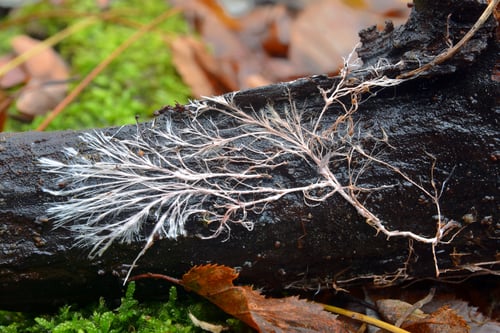Legend has it that trees talk to each other. You might have even pondered if a falling tree goes unnoticed in an otherwise empty forest. This magical image of talking trees—seen in movies, mythology, and ancient folklore—actually has some truth to it. They may not have mouths, but trees do have their own way of communicating: a network of roots found just beneath the forest floor.
It turns out, trees have a lot to say. At the first sign of dangerous pests, a single affected tree can alert the rest of the forest, giving its friends time to arm themselves with defensive compounds. Trees also use their root connections to provide parental care that resembles what we see in the animal kingdom. Blocked from life-giving sunlight as they spring from seeds within the earth, saplings rely on nutrients transferred from their older, taller neighbors to continue growing in strength and stature. Trees even show preference for family, sharing nutrients, sugar, and water with their own kin.

Dense webs of microfilaments—called “mycelium”
To accomplish this communication and resource-sharing, trees need the help of something less like plants and more closely related to animals: fungus. While your fungal imagination might conjure enticing images of furrowed morels waiting to be sliced open or delicious wafts of chanterelles sizzling in butter, the mushrooms you eat are just the reproductive parts of a fungus, small but mighty anatomies that burst forth at the first hint of warm soil and moisture. But most of a fungus’s body lies underground, where its dense webs of microfilaments—called “mycelium”—can extend thousands of miles. A marvel of nature, one mycelium holds the record of being the largest organism in the world, spanning over 2,000 acres; it is believed to be almost 2,000 years old. Intricately branched mycelial membranes resemble human brain cells, right down to their ability to transfer electrical impulses in response to the environment.
But how exactly does mycelium help trees? The fungi fuse with the plants, inserting themselves into the hairlike root tips of trees. Vast networks of mycelium can extend farther than any individual root system, and thus are able to distribute resources between trees in different environments. Fungi can also access minerals from the soil that the roots could not directly absorb. These resources can then be taken up by trees that would otherwise grow thirsty, starved, or malnourished. Dr. Suzanne Simard, who discovered this network, refers to it as the “Wood Wide Web” because of its similarity to today's modern internet.
The fungi do not work for free. As compensation for their crucial services, mycelium retains about 30% of the sugars produced through photosynthesis by the connected trees. Through this interaction, fungi obtain energy to grow and continue working as the underground internet for forest ecosystems.
On a quest to see mycelium for yourself? Simply flip over a fallen log and search for a web of white fibers resembling cottony fluff, or start your endeavor near mushrooms that you find nestled in a moist hiding spot along the forest floor. Incorporate this hunt on your next walk in the woods to get a better appreciation of the miniscule and delicate organism responsible for fortifying mighty forests across the globe.
When a tree falls in the woods, it’s safe to say that its neighbors hear the thunderous collapse and are using mycelium to chat about it.
Lucy Trosper is a Naturalist at Walking Mountains Science Center. As an aspiring tree translator and fungi fanatic, you can always find Lucy wandering in the woods.







